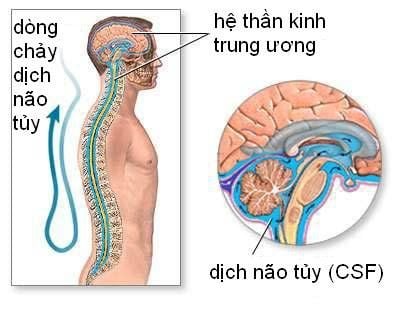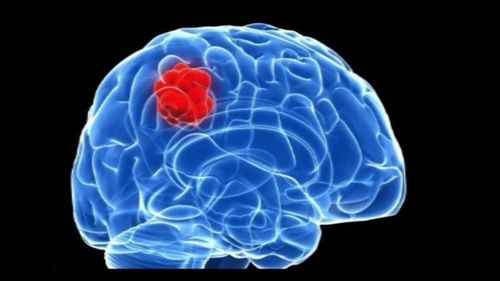This is an automatically translated article.
The growth rate of a brain tumor depends on several factors such as the location of the brain tumor. Because it will determine how much it affects the function of the nervous system. Furthermore, the choice of treatments for brain tumors also depends on the location of the tumor, the type of tumor acquired, and the size of the tumor.
1. Brain Cancer
Brain cancer has many types, and causes can be due to:
Brain tumors that start in the brain: Primary brain tumors start in the brain itself or in tissues near it, such as in the meninges, cranial nerves, pituitary or pineal gland. Primary brain tumors begin when normal cells mutate in their DNA. These mutations allow cells to grow and divide at an accelerated rate and continue to live when healthy cells die. The result is a mass of abnormal cells, forming a tumor. In adults, primary brain tumors are much less common than secondary brain tumors, in which the cancer begins elsewhere and spreads to the brain.
Cancer that started elsewhere and metastasized to the brain: Secondary (metastatic) brain tumors are tumors caused by cancer that start elsewhere in the body and then metastasize (metastasize) to the brain . Secondary brain tumors most commonly occur in people with a history of cancer. But in rare cases, a metastatic brain tumor can be the first sign of cancer starting elsewhere in the body.
In most people with primary brain tumors, the cause of the tumor is not clear. But doctors have identified a number of factors that can increase the risk of brain tumors. Risk factors include:
Exposure to radiation. People who have been exposed to a type of radiation called ionizing radiation have a higher risk of developing brain tumors. Examples of ionizing radiation include radiation therapy used to treat cancer and radiation exposure caused by atomic bombs. Family history of brain tumor. A small fraction of brain tumors occur in people with a family history of brain tumors or a family history of genetic syndromes that increase the risk of brain tumors.
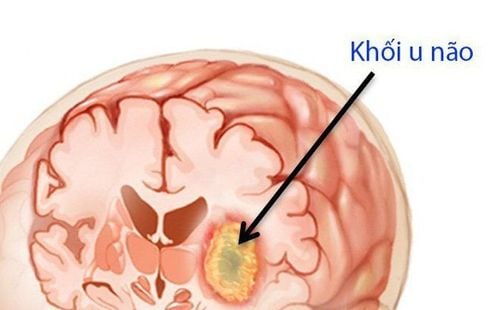
Các khối u não nguyên phát bắt đầu khi các tế bào bình thường đột biến trong DNA của chúng
2. A few problems before brain cancer treatment
Brain cancer treatments and care plans including treatment of symptoms, and side effects. Moreover, the important part is the medical care for the sick person.
Treatment options and recommendations depend on several factors:
The size, type and grade of the tumor Whether the tumor is putting pressure on important parts of the brain If the tumor has spread to other parts of the central nervous system or the body Possible side effects Patient preferences and overall health Some types of brain tumors grow rapidly; Other tumors grow slowly. Taking all of these factors into account, your doctor will talk to you about how soon treatment should be started after diagnosis. Treatment options include surgery, radiation, chemotherapy, and targeted therapy.
3. Surgery to treat brain cancer
Brain and spinal cord cancer surgery may be done to:
Take a biopsy sample to determine the type of tumor Remove the tumor (or as much as possible) Help prevent or treat symptoms or complications Possible symptoms of the tumor Before having surgery, be sure to understand the goals of the surgery, as well as the possible benefits and risks.
3.1. Surgery to remove the tumor
Usually, the first step in treating a brain or spinal cord tumor is for a neurosurgeon to safely remove as much of the tumor as possible without affecting normal brain function .
Surgery alone or in combination with radiation therapy can control or cure many types of tumors, including some low-grade astrocytomas, ependymomas, craniopharyngiomas, gangliogliomas, and meningiomas.
Tumors that tend to spread into nearby brain or spinal cord tissue, such as astrocytomas or glioblastomas, often cannot be cured with surgery. But surgery is often done first to reduce the number of tumors that need to be treated with radiation or chemotherapy, which can help these treatments work better. This could help prolong a person's life, even if the entire tumor cannot be removed.
Surgery may also be done to help relieve some of the symptoms caused by a brain tumor, especially those caused by a buildup of pressure in the skull. These can include headaches, nausea, vomiting, and blurred vision. Surgery can also make it easier to control seizures with medication.
Surgery to remove the tumor may not be a good option in some situations, such as if the tumor is deep in the brain, if it is in a part of the brain that cannot be removed, such as brain stem or if the person is unable to have major surgery for other health reasons.
Surgery is not effective for some types of brain tumors, such as lymphoma, although it can be used to obtain a diagnostic biopsy sample.
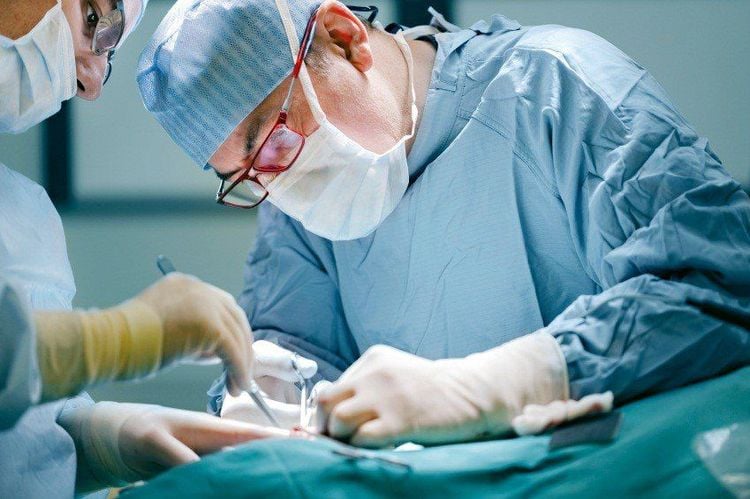
Phẫu thuật cũng có thể được thực hiện để giúp giảm một số triệu chứng do khối u não gây ra
Craniotomy is an open surgery within the skull. This is the most common approach to surgically treating brain tumors. The patient may be under general anesthesia or may be awake for at least part of the procedure if brain function assessment is needed during surgery.
Part of the head can be shaved before surgery. First, the neurosurgeon makes a scalp incision over the skull near the tumor and folds the skin. A special drill is used to remove the skull fragment above the tumor.
The opening is usually large enough that the surgeon can insert some instruments and see the parts of the brain needed for safe operation. The surgeon may need to manually cut into the brain to access the tumor. The surgeon may use an MRI or CT scan done before surgery (or may use ultrasound when the skull has been opened) to help locate the tumor and its edges.
The surgeon can remove the tumor in different ways depending on how hard or soft and the tumor has many or only a few blood vessels:
Many tumors can be removed with a scalpel or solid scissors separate. Some tumors are tender and can be removed with suction devices. In other cases, a hand-held ultrasound machine may be placed into the tumor to break up the tumor and suck it out. Many devices can help the surgeon see the tumor and surrounding brain tissue. Surgeons usually operate while looking at the brain through a special microscope. An MRI or CT scan may be done before surgery (or an ultrasound may be used when the skull has been opened) to map the area of the tumor deep in the brain. In some cases, surgeons use intraoperative imaging, where MRI images (or other images) are taken at different times during surgery to show the location of any abnormalities. any remaining tumor. This could allow some brain tumors to be resuscitated more safely and more widely.
Remove as much of the tumor as possible while trying not to affect brain functions. Surgeons can use different techniques to reduce the risk of removing important parts of the brain, such as:
Intraoperative cortical stimulation (cortical mapping): In the approach In this, the surgeon electrically stimulates parts of the brain in and around the tumor during surgery and monitors the response. This can be seen if these regions control an important function (and therefore should be avoided). Functional MRI: This type of imaging test may be done before surgery to determine specific brain function. This information can be used to identify and preserve the area during operation. Fluorescent-guided surgery: For some types of tumor, such as glioblastoma, the patient may be given a special fluorescent dye before surgery. The dye is absorbed by the tumor, which then glows as the surgeon examines it under the fluorescent light from the operating microscope. This allows the surgeon to better separate the tumor from the normal brain tissue. Newer techniques: Newer types of MRI, as well as newer surgical methods, may be helpful in some cases.
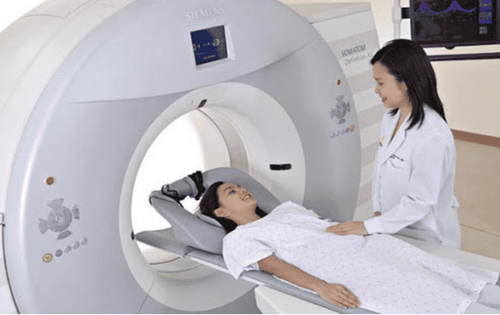
Chụp MRI hoặc CT có thể được thực hiện trước khi phẫu thuật
After the brain surgery is complete, the skull fragment is put back in place and secured with screws and metal plates, wires or special sutures. Usually any piece of metal is made from titanium, this allows a person to have a follow-up MRI scan.
You may have a drainage tube out of the incision to allow excess cerebrospinal fluid (CSF) out of the skull. Other drains may be placed to allow blood that has accumulated after surgery to drain from under the scalp. These drains are usually removed after a few days. Imaging tests such as an MRI or CT scan are usually done 1 to 3 days after surgery to confirm how much tumor has been removed. Recovery time in the hospital is usually 4 to 6 days, although this depends on the size and location of the tumor, the patient's general health, and whether other treatments are performed. . Healing around the surgical site usually takes several weeks.
3.3. Surgery to help stop the flow of cerebrospinal fluid
If a tumor blocks the flow of cerebrospinal fluid (CSF), it can increase pressure inside the skull (known as raised intracranial pressure, or ICP). This can cause symptoms like headaches, nausea, and drowsiness, which can even be life-threatening. Surgical removal of the tumor can often help with this, but there are other ways to drain excess cerebrospinal fluid and relieve pressure if needed.
Shunts can be temporary or permanent. They may be placed before or after surgical removal of the tumor. Placing a shunt usually takes about an hour. As with any surgery, complications can develop, such as bleeding or infection. A stroke is also possible. Sometimes shunts get clogged and need to be replaced. The hospital stay after a shunt procedure is usually 1 to 3 days, depending on the reason for the procedure and the general health of the patient.
Another option for treating increased pressure in the skull in some cases is endoscopic third ventriculostomy (ETV). During this surgery, an opening is made in the floor of the third ventricle at the base of the brain to allow cerebrospinal fluid to flow again. This operation is done through a small hole in the front of the skull. One advantage of this method is that it does not require a shunt. But it's also possible that the hole in the ventricle could close, which is common in people with brain tumors.
If the pressure inside the head needs to be relieved for a short time, an external ventricular drain (EVD) may be placed to allow excess CSF to drain. The drain is a small tube. One end is inserted into the ventricles, the other end is attached to the collecting sac outside the body. Along with collecting excess cerebrospinal fluid, a drain can also be used to measure pressure inside the skull, as well as look for tumor cells, blood, or signs of infection in the cerebrospinal fluid.
The drain can be placed during surgery or during the procedure at the patient's bedside. It may be placed to relieve pressure in the days before surgery, or to help drain fluid that builds up after surgery. If the pressure inside the skull needs to go down for more than a few days, the doctor may need to change this pressure to a VP shunt.
3.4. Ventricular septal catheterization surgery
Surgery can also be used to insert a catheter into the ventricles, such as an Ommaya reservoir, to help deliver chemotherapy drugs directly into the CSF. A small incision is made in the scalp and a small hole is drilled in the skull. Then, a flexible tube is threaded through the hole until the open end of the tube is in the ventricle, where it reaches the cerebrospinal fluid. The other end, which has a dome-shaped reservoir, is located just below the scalp. After surgery, doctors and nurses may use a thin needle to pass chemotherapy drugs through a reservoir or remove cerebrospinal fluid from the ventricles for testing.
4. Possible risks and side effects of surgery
Brain or spinal cord surgery is a serious surgery and surgeons take great care to try to limit any problems during or after surgery. Complications during or after any type of surgery can include bleeding, infection, or a reaction to the anesthetic, although these are uncommon.
A major concern after surgery is swelling in the brain. Medicines called corticosteroids are usually given before and for a few days after surgery to help reduce this risk.
Seizures can also occur after brain cancer surgery. Anti-seizure medications can help reduce this risk, although they may not prevent them completely.
One of the biggest concerns with brain tumor removal is the possible loss of brain function afterward. That's why doctors are very careful to only remove as much tissue as possible. If problems arise, it could be right after surgery, or it could be days or even weeks later, so it's important to keep a close eye on any changes.
Early cancer screening is considered a perfect measure in the timely detection and treatment of all types of cancer. Vinmec International General Hospital currently has a high-tech cancer screening and examination package, including genetic testing, imaging, and biomarkers for early tumor detection. A single gene test can assess the risk of 16 common cancers in both men and women.
Please dial HOTLINE for more information or register for an appointment HERE. Download MyVinmec app to make appointments faster and to manage your bookings easily.
Reference source: cancercouncil.com.au; cancer.net; cancer.org; mayoclinic.org
MORE:
Chemotherapy for brain cancer Risk factors for brain cancer Brain cancer treatment options








